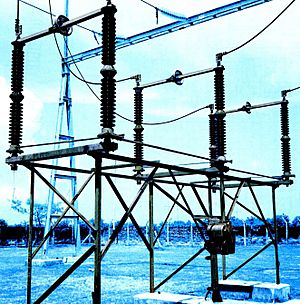Disconnecting switch facts for kids
A disconnecting switch (also known as a disconnector) is a special kind of electrical switch used in electrical circuits that carry very high voltage (a lot of electrical power). Its main job is to completely separate one part of an electrical system from another. This is super important for safety! When electricians or engineers need to work on electrical equipment, they use these switches to make sure no electricity can accidentally reach the area they are working on. It's like turning off the main water valve before you fix a leaky faucet in your house.
Contents
What is a Disconnecting Switch?
A disconnecting switch is a device that creates a clear, visible gap in an electrical circuit. Imagine a train track: if you remove a section of the track, no train can pass. A disconnecting switch does something similar for electricity. When it's "open," you can actually see the space between the parts that carry electricity, which means the power is definitely off. This visible gap is key for ensuring safety during maintenance or repairs on high-voltage equipment.
Why Are They So Important?
Disconnecting switches are vital for keeping people safe who work with electricity. Electricity, especially high-voltage electricity, can be very dangerous. Before anyone touches electrical wires or machinery for repairs, they need to be absolutely sure that no electricity is flowing. The disconnecting switch provides this guarantee by physically breaking the circuit. It's a critical step to prevent accidents and protect lives.
How Do They Work?
Unlike a regular light switch you might have at home, which can turn off power even when there's a problem, a disconnecting switch is usually operated when there is no electricity flowing through it. This means it's not designed to stop a sudden surge of power. Instead, it's used to manually open or close a circuit when the power has already been turned off by another device, like a circuit breaker. Once the circuit breaker has stopped the flow of electricity, the disconnecting switch is then opened to create that visible, safe gap.
Disconnecting Switches vs. Circuit Breakers
It's easy to confuse disconnecting switches with circuit breakers, but they have different jobs:
- A circuit breaker is like an automatic safety guard. It can quickly stop the flow of electricity if there's a problem, like too much power or a short circuit. It's designed to protect equipment and prevent fires.
- A disconnecting switch is a manual safety device. It's used to completely isolate a section of the electrical system for maintenance. It's not designed to break the circuit when electricity is flowing, but rather to ensure a safe, visible separation once the power has already been turned off.
Where Are Disconnecting Switches Used?
You'll find disconnecting switches in places where large amounts of electricity are handled. This includes:
- Power substations: These are places where electricity is transformed from very high voltages to lower voltages for homes and businesses.
- Power plants: Where electricity is generated.
- Industrial facilities: Factories and other large buildings that use a lot of power.
- Transmission lines: The big power lines that carry electricity across long distances.
They are essential components in the electrical grid, making sure that power can be safely managed and maintained.
See Also


